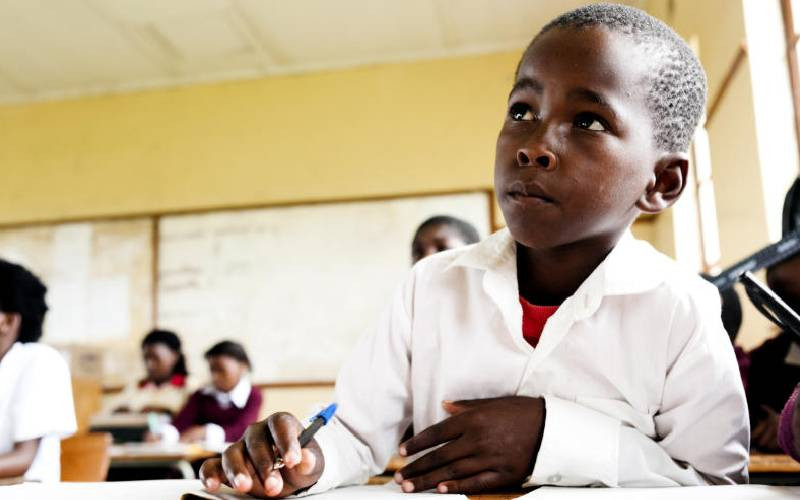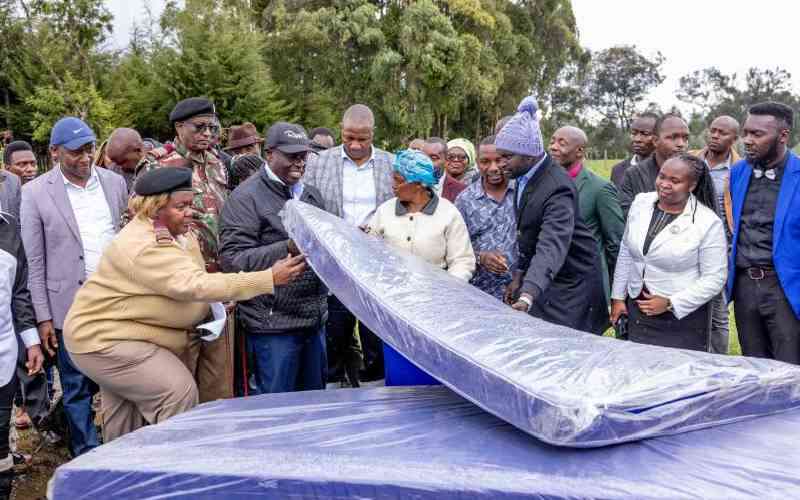 |
|
Kakamega High National School students, seek divine intervention at the school over the weekend before the start of this years KCSE exams later in the week. |
NAIROBI, KENYA: The Government is accused of sitting on a report that could drastically reduce secondary school fees and bring most parents some much-needed relief.
Former Assistant Minister for Education Kilemi Mwiria chaired the 21-member Task Force on Secondary School Fees 2014 that authored the report, but the Government is worried it may not be able to foot the bill.
In bold measures to lower the cost of education, the team proposes that the maximum fees parents should pay for boarding schools be Sh41,574, Sh13,708 for day schools and Sh35,435 for special schools annually.
Currently, parents pay up to Sh100,000 in school fees each year, and the high cost has prevented many students from pursuing their dreams.
And the fees could be lowered even more if the Jubilee administration meets its promise to increase the State subsidy. Currently, the Government pays Sh10,265 per student in secondary schools although the money often delays. Officials have promised to increase the capitation to Sh13,000 per student.
Students in special schools get an allocation of Sh20,000 per year. A survey by the task force established that students in national secondary schools currently pay up to Sh99,950 each annually.
Fees in Extra County schools (boarding schools with a mean score of above 6.5) average Sh54,523 per student every year. Sub-County schools- (day schools and former provincial schools with day wings) charge about Sh25,374 per student annually.
By proposing that school fees be classified under only boarding, day and special schools, the team appointed by Education Cabinet Secretary Jacob Kaimenyi to review the cost of secondary education proposes to eliminate these varying and expensive categories.
It has capped the maximum cost of a set of school uniform at Sh4,900, a huge cut from Sh13,000 charged in some schools, and placed limits on other levies like cost of meals, learning material and construction.
The team’s major task was to establish the realistic costs of quality secondary education that would still make it accessible to all Kenyans. The new costs per item take into account school type, costs of various inputs, per-capita spending, school activities and the overall school budget.
The document seen by The Standard says the Ministry of Education must regulate secondary school fees based on only three categories: day, boarding and special needs schools.
“However any school with special circumstances necessitating school fees variation should make a written justification to the cabinet secretary who will study and give clearance or otherwise,” reads the report.
SCHOOL UNIFORMS
In their firm recommendations, the team proposes cost cutting measures to lower the cost of secondary education.
They range from eliminating unnecessary levies, limiting the components of school uniform to essential elements and developing a standard school meals policy unique to each county.
Stay informed. Subscribe to our newsletter
Also proposed are effective staffing norms, constant maintenance of school facilities and how to cut the cost of school utilities.
The committee proposes that the cost of teaching and learning materials be put at flat rate of Sh4,792 for both boarding and day schools. Previously, this vote was referred to as tuition fees. It will cover items such as textbooks, assessment materials, laboratory equipment and chemicals, computer accessories, national examination fees and stationery.
“Despite FDSE (the Government’s annual capitation), schools have continued to charge parents for duplicating paper, exercise books, dictionaries, atlas and bible,” reads the report
The cost of meals, (lunch for day schools), boarding, equipment and stores is recommended to be a flat rate of Sh24,721 in national, special and boarding schools. Day schools will however charge Sh5,861 under this vote. This cost will cater for meals and replacement of dining equipment including gas and wood.
The team also proposes a medical and insurance vote that will cover first aid drugs and kits, emergency medical bills, group accident or group emergency for students, teachers and non-teaching staff.
Repairs, maintenance and improvement fee in day schools will be Sh1,440. National schools will charge Sh2,437 as special schools have been proposed to charge Sh1, 849. “All schools will need to constantly maintain school facilities and buildings in order to improve quality of learning environment.”
The team has, however, scrapped the Parents and Teachers Association fund. “Because of being the subject of much abuse, no allocation was given to this vote head,” reads the document.
Pressure is now piling on Kaimenyi to make the report public for debate and subsequent implementation. Secret correspondence between the members of the task force point at a furious and frustrated team, and fears that the report will gather dust on the ministry’s shelves even as parents continue to pay more fees.
DELAYED ALLOWANCES
The members of the team are also incensed by the delayed payment of their allowances. “The report is ready and has even been published. We do not know why Kaimenyi is sitting on it,” said one of the members.
The task force members included representatives from the two teachers’ unions, parents associations, Elimu Yetu Coalition, School Heads association, Kenya Private Sector Alliance, religious organisations and assortment of other education stakeholders.
A member of the task force’s secretariat who asked not to be named because the document is still under lock and key confirmed that they had completed their work. On school uniforms, only essential elements should be part of the school dressing code, according to the report.
If adopted the maximum cost a school uniform would cost is Sh4,900 down from an average cost of Sh8,700 per student. Currently, parents pay between Sh4,850 and Sh13,000 on uniform alone. “The cost can be lower depending on the region and school locality. Schools should not include nonessential components such as blazers as part of school uniform,” reads the report.
The basic uniform components have been listed as a short or skirt, shirt or blouse, a necktie, sweater, socks and footwear. A sunhat has also been listed as key learners with albinism. Others are activity fees, medical, personal emolument, electricity water and conservancy and administration costs.
 The Standard Group Plc is a
multi-media organization with investments in media platforms spanning newspaper
print operations, television, radio broadcasting, digital and online services. The
Standard Group is recognized as a leading multi-media house in Kenya with a key
influence in matters of national and international interest.
The Standard Group Plc is a
multi-media organization with investments in media platforms spanning newspaper
print operations, television, radio broadcasting, digital and online services. The
Standard Group is recognized as a leading multi-media house in Kenya with a key
influence in matters of national and international interest.
 The Standard Group Plc is a
multi-media organization with investments in media platforms spanning newspaper
print operations, television, radio broadcasting, digital and online services. The
Standard Group is recognized as a leading multi-media house in Kenya with a key
influence in matters of national and international interest.
The Standard Group Plc is a
multi-media organization with investments in media platforms spanning newspaper
print operations, television, radio broadcasting, digital and online services. The
Standard Group is recognized as a leading multi-media house in Kenya with a key
influence in matters of national and international interest.








